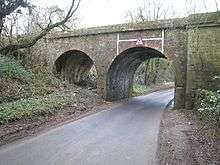Cirencester branch line
| Cirencester branch line | ||||||||||||||||||||||||||||||||
|---|---|---|---|---|---|---|---|---|---|---|---|---|---|---|---|---|---|---|---|---|---|---|---|---|---|---|---|---|---|---|---|---|
| ||||||||||||||||||||||||||||||||
The Cirencester branch line was a five mile long single-track branch railway line that ran from Kemble railway station on the Great Western Railway Golden Valley Line to Cirencester Town via two intermediate stations, Park Leaze Halt, and Chesterton Lane Halt and contained the highest rail crossing point on the River Thames.
History

Opening
In 1841 the branch was opened by the Cheltenham and Great Western Union Railway[1] to provide a 17 1⁄2 mi (28.2 km)[2] link via Kemble to the Great Western Railway network at Swindon. For its first 4 years, until opening of the main line, it was a railhead for Stroud, Cheltenham and Gloucester, with connecting coaches and was leased to GWR. Herapath's Journal said, "The distance from Cheltenham to Cirencester is only 14 miles, with an excellent turnpike road."[3] The branch was converted from broad to standard gauge between 22 and 27 May 1872.[1]
Stations
Cirencester got a second station when the Midland and South Western Junction Railway opened a station at Watermoor in 1883. The line's terminal, Cirencester station was renamed Cirencester Town in July 1924. A new halt was opened at Chesterton Lane in 1959 and a second, Park Leaze Halt, was opened on 4 January 1960.
Operation
In later years the branch was worked by 57XX and, on through trains to Swindon, by 5101 Class. They were replaced on 2 February 1959 by AC Railbuses. Passenger trains normally took 8 minutes between Kemble and Cirencester. As the railbuses were too light to operate track circuits, they only ran empty to and from Swindon for maintenance, ending the through services. In 1914 there were 11 or 12 trains in each direction, reduced to 10 by 1951, but increased to 14 with the railbuses.[1]
Closure
The line was closed in April 1964 (along with the neighbouring branch to Tetbury) as a result of the Beeching Axe. At the same time, Cirencester's other line closed, so freight was concentrated on this branch, but that ended in June 1964, after which only coal traffic used the line.[1] That ended and the line closed on 4 October 1965.[4]
A Cirencester ring road was built on part of the railway in the mid 1970s.[5]
Future
As of 2016, discussions have taken place regarding the potential of relaying 5km of track from Kemble railway station to the edge of Cirencester[6] at Chesterton Halt.[7]
References
- 1 2 3 4 Tolson, John M. (October 1964). "End of an Experiment". Railway Magazine. Retrieved 2017-05-23.
- ↑ "Herapath's railway journal, Volume 6". archive.org. March 1839. Retrieved 2017-06-01.
- ↑ Herapath's Railway Journal. 1837.
- ↑ "Cirencester Town disused railway station – Victorian Gothic stuck in a car park". urban75 blog. 2011-09-26. Retrieved 2017-05-30.
- ↑ "Railway and Station, Cirencester, Gloucestershire | Educational Images | Historic England". historicengland.org.uk. Retrieved 2017-05-30.
- ↑ http://m.wiltsglosstandard.co.uk/news/14507152.Cirencester_railway_plans_steaming_ahead_after_Government_meeting/
- ↑ "Ciren-Kemble Railway - The Plan". cirentrain.org.uk. Retrieved 2017-05-30.